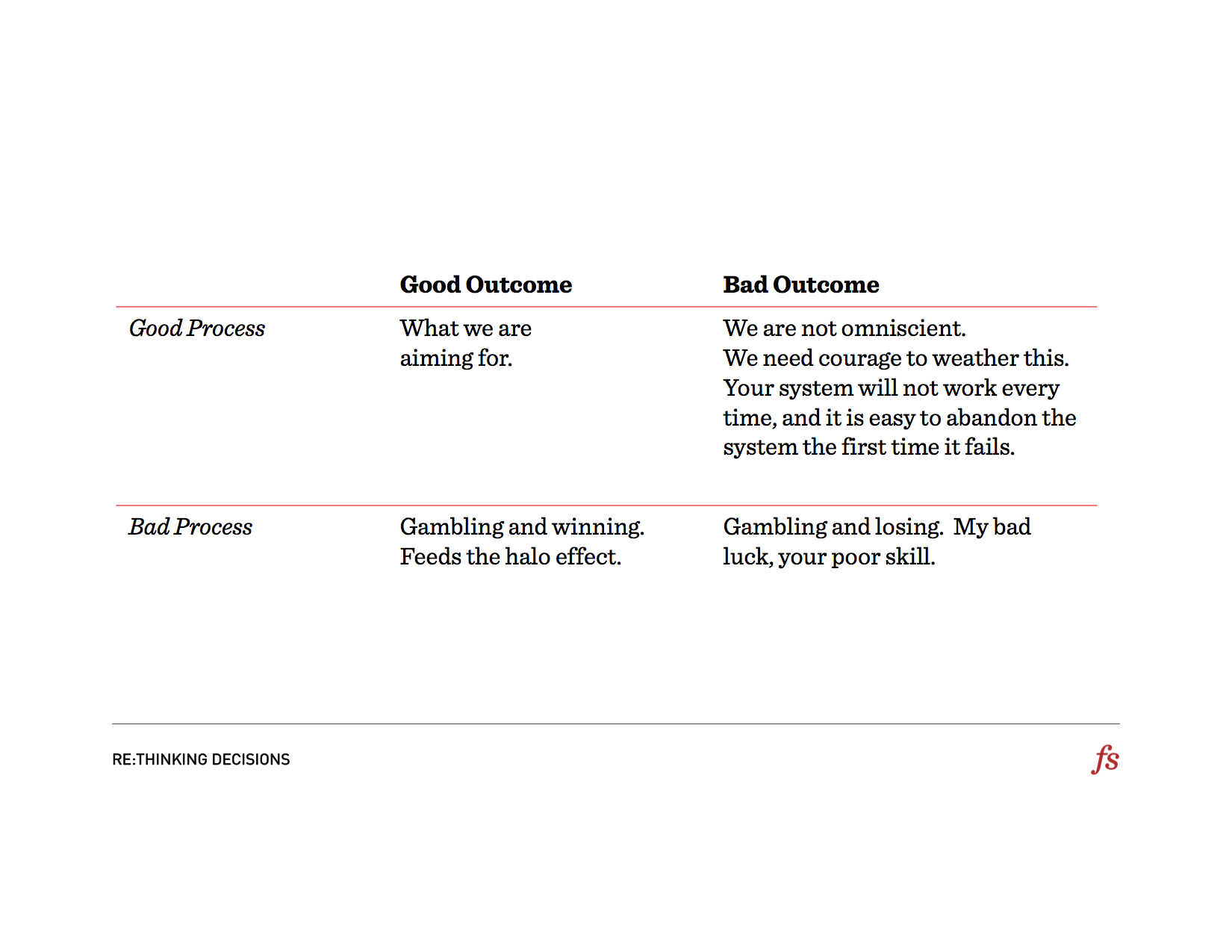Good decisions don’t always have a good outcome, just as bad decisions don’t always have bad outcomes. Sometimes bad outcomes happen to good decisions. And sometimes good things happen to bad decisions. Learning to distinguish between when you’re brilliant and lucky is the key to rapid improvement.
When other people make decisions with bad outcomes, we tend to focus on the people behind the decision. We can’t seem to shake the belief that good people make good decisions and bad people make bad decisions. It’s easy to think that we would have made a better decision.
When our decisions have bad outcomes, we know the outcomes is not all there is to see. Our thoughts and intentions come into play. We can’t see the thoughts and intentions of others—we only see their actions through a biased lens. We can, however, see our thoughts and intentions. Our bad outcomes happen because we were unlucky.
The Decision Outcome Matrix
Consider this simple two-by-two decision outcome matrix.

We want to deserve success. Everyone wants to be in the upper left box — a good process that results in a good outcome. The problem is the world doesn’t always comply with our wishes. Following a good process can lead to a bad outcome because of uncertainty.
A good process with a bad outcome requires that we remember nothing is for sure.
Bad outcomes from a bad process require a choice. If we are delusional and let our ego dominate, we mistakenly see this as bad luck. While we are aware that we had a negative outcome, we are unaware that it resulted from a bad process. In this case, we learn nothing. We are doomed to repeat our mistakes. More self-reflective people see bad outcomes resulting from bad process as an opportunity to learn as much as we can to avoid repeat failures.
Perhaps the worst quadrant to be in it the lower left — a bad process leads to a good outcome. Ignoring the fact that this isn’t repeatable, we convince ourselves that we deserved success.
If you can’t recognize when you’ve had ‘dumb luck,’ you’ll never be in a position to correct the way you’re making decisions. Eventually, your luck runs out.
Of course, it’s easier to place others into the matrix than ourselves. When it comes to others, we see more of reality because we’re a disconnected observer. When it comes to ourselves, however, we default to ego protection.
One of the ways to calibrate your decisions is to use a decision journal. A good decision is known before the outcome. It involves a mental representation of the facts known at the time as well as applied judgment. Good decisions are valuable, but they are more valuable if they are part of a good decision process because a good process allows for feedback about where you can improve. This feedback, in turn, allows you to constantly get better at making decisions.
Article Summary:
- Good decisions don’t always have a good outcome. Bad decisions don’t always have bad outcomes.
- Bad outcomes can happen to good decisions.
- When other people have a bad outcome, we tend to think they made a bad decision. When we have a bad outcome, we tend to focus on intentions.
- There is a simple 2*2 matrix to help you see what happened. On one axis is Good/Bad Process, on the other is good/bad outcome.
- A bad process with a good outcome is gambling and winning. This is the most dangerous quadrant.
- A bad process with a bad outcome is gambling and losing.
- A good process with a bad outcome needs to be put into perspective.
- You can calibrate your decisions using a decision journal.
